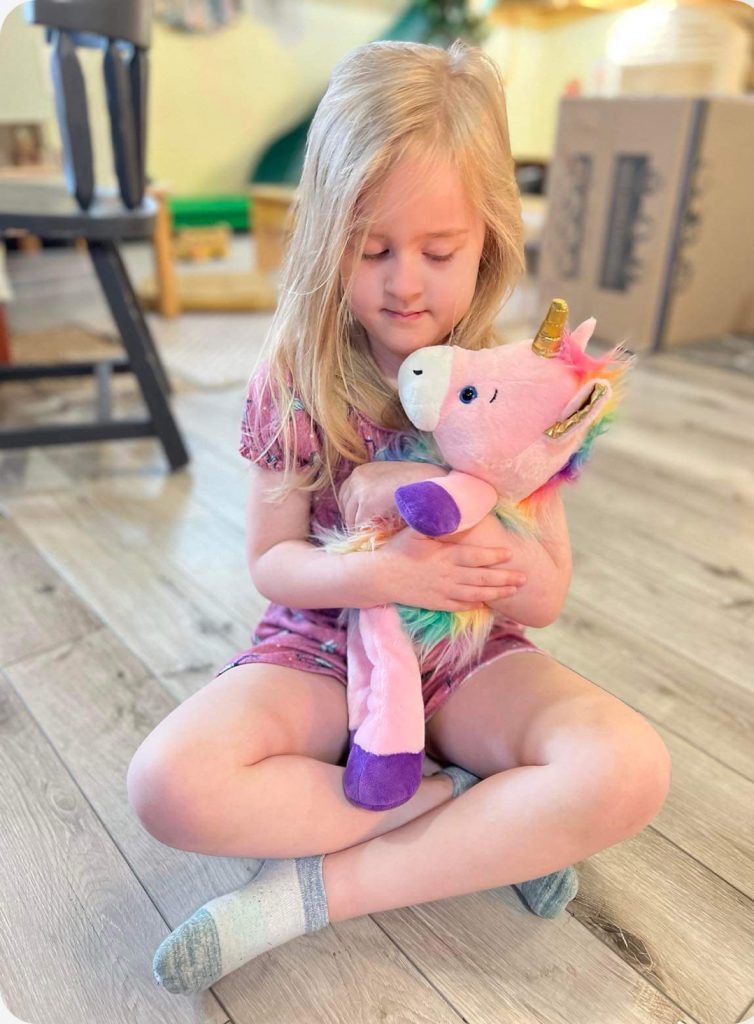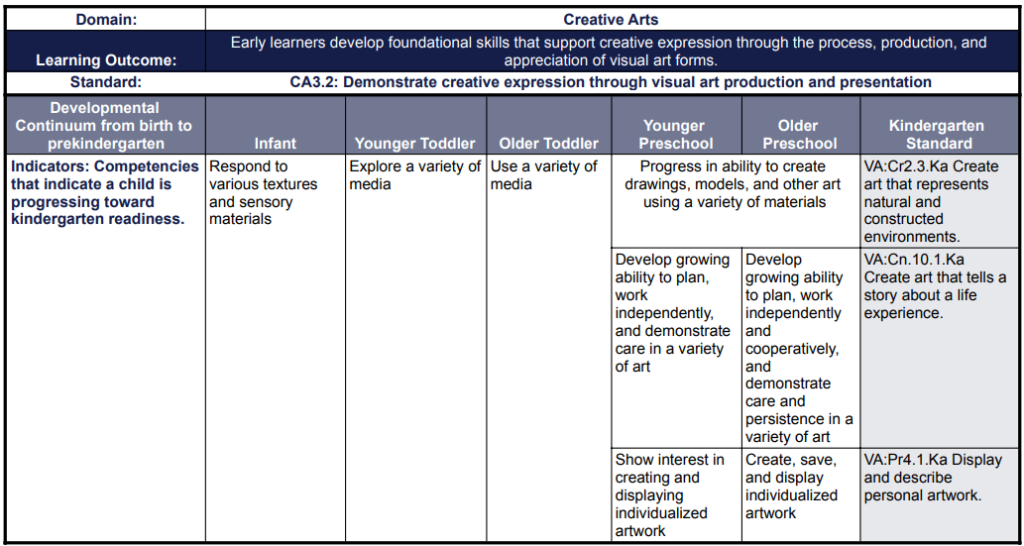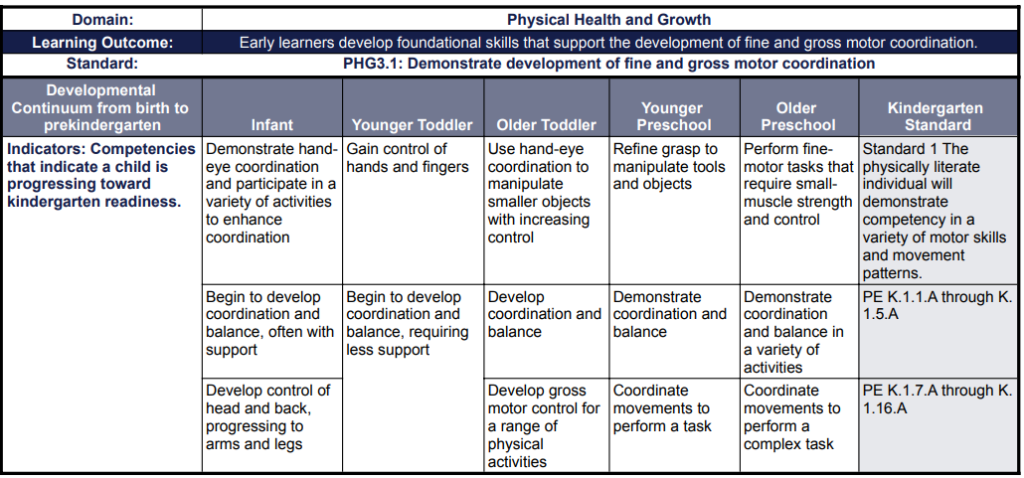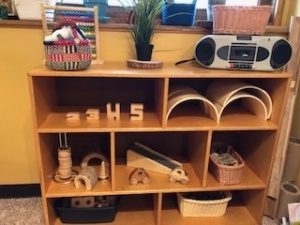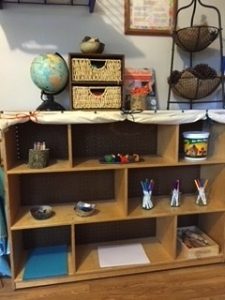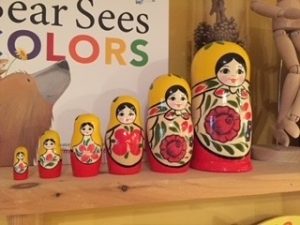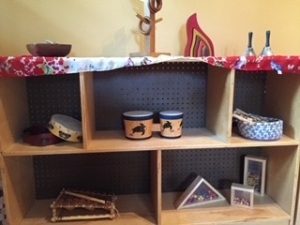As part of our social emotional learning curriculum, we read a story about a different social-emotional concept using sight, touch, and sound to engage children and solidify the skill-building process.
I always incorporate a stuffed animal that correlates to a different social or emotional need. For example, unicorns for creativity, bears for feeling love, sloths slowing down, snail feeling brave. My goal is to tell a story or read a book I find about that SEL goal and pass the stuffed animal around and help them believe in themselves and their abilities. To remind them we can get through hard times, and we don’t have to do it alone.
Daily we work on positive affirmations and the idea that their opinions about themselves matter. We’ve also talked about how to handle difficult situations and when to ask for help. Being a teacher, I’m doing everything in my power to help guide, kind, empathetic, and strong kids.
Social Emotional Learning is instilling feelings of self-worth into our kids. We use affirmations in response to many situations, like conflict-resolution needs, self-esteem needs, and emotional regulation needs to name a few. And using affirmations daily I notice the kids pulling out these types of positive sayings on their own, without my initiation.
The specific skills the children are learning include:
- Interaction — physical touch, eye contact, and playfulness
- Connection — reading positive affirmations and having them repeat them to you (if possible)
- Reflection — practicing the learned concepts and skills
As teachers we honor the emotional lives of children and enable them to find the words to express themselves as they come to terms with their complex feelings.
Family child care providers are more likely than most early childhood educators to work with mixed age groups, which can broaden the differences in abilities to plan for. But all children develop at different rates, with different interests and abilities, so even when an activity is only for three-year-olds, the particular three-year-olds who are participating are going to determine the types of adaptations and levels that are planned for.
When writing a lesson plan, including adaptations for children who need more assistance or more challenging stimulation can seem daunting at first, but soon will become second nature. Consider the following factors when planning appropriate modifications– we’ll test it out on a planned activity after:
- Safety first! Are the children using risky tools (hammers/nails, hot glue, etc.) that could be misused if a child’s attention, impulse control, or motor skills are not at a certain level? Consider partnered work, having one “helper,” adapting tools (loop scissors instead of regular scissors, tacky glue instead of hot glue), or working hand-over-hand.
- Look at your goal for the activity: have any of the children already accomplished it? Is it too far out of the zone of proximal development for some children to attempt? Are there smaller steps those children can take to meet that goal?
- What can children who finish early do? Have a plan for the ones who lose interest early as well as the ones who want to keep working and experimenting.
SAMPLE ACTIVITY & INDIVIDUALIZED ADAPTATIONS:
Audience: Children 2-5 years old
Activity: Tissue paper collage on contact paper
Learning Outcomes (from IN Early Learning Standards):
Adaptations: Children will be offered pencils and loop scissors, as well as traditional safety scissors, to create and cut out designs from tissue paper. Children will be encouraged to tear the paper by hand if not yet able to use scissors consistently. Children may work with the contact paper at easels, on the table, or on trays on the floor to allow optimal body positioning. Children can work until finished, and those who finish first/early may wash up and move on to open centers for free play.
When planning a child-focused curriculum, it’s important to notice how children are using the materials. This observation form is made to be used repeatedly over the course of a week or two to allow providers to notice how children are using materials, and plan what additional materials or provocations can be added to extend childrens’ interests. There are also spaces to note early learning standards that children are addressing through interacting with the centers.
Looking for an interesting textural addition to your play dough? Add birdseed and try this no-cook recipe, written to use with young children. Note: Skip the food coloring you might normally use to allow children to really notice the distinct colors of each type of seed.
- 2 ½ cups All-Purpose Flour
- ¾ cup Salt
- 2 tablespoons Cream Of Tartar
- ¼ cup Vegetable Oil
- 1 ¼ cups Boiling Water
- 2 cups birdseed
- Help children measure the dry ingredients.
- In a large bowl, have each child add an ingredient then take turns whisking together the flour, salt and cream of tartar.
- Adult adds the vegetable oil and boiling water, and using a spatula, mix until combined.
- Once it’s cool enough to handle, bring the children back together to knead the playdough in the bowl until it becomes smooth, about 2 minutes. (It may appear wet at first but will dry as you knead and the water gets fully absorbed.)
- Form the dough into a “bowl” and add birdseed to the center. Help children incorporate the seeds into the dough.
Within the Reggio Emilia approach, and now in many early childhood programs, the environment where children spend their time is typically called the third teacher. The environment helps determines the flow of the day, what children learn and how they interact with one another. Having the right amount, variety, and types of materials in an early childhood classroom will make the day run more smoothly and will be more engaging for the children, thus in turn will make it easier for the teacher.
Knowing the why, when, and how to rotate toys is important and a worthwhile task, based upon information gathered through child observations. Through observations of the children in care, we can determine if, when, and what types of materials need to be rotated in the environment. The provider knows the children in their care very well and soon can see patterns emerge that will help the provider make specific adjustments in the environment.
Let’s consider some of the reasons why we rotate toys in a childcare environment.
A child may have mastered a certain skill and by changing specific materials in the classroom we can help scaffold the child to the next skill level. Children learn through facing appropriate challenges, but it’s important to make the challenge achievable. We don’t want the child to feel frustrated or lose interest. A skilled teacher is able to observe students and notice these small changes and find materials that will spark curiosity and interest. We may want to teach a new skill. Placing new toys and materials in the classroom can help a child learn a new skill, such as sequencing, stacking, or balancing. We may also want to challenge that skill and make it slightly more difficult by adding something new to use. Safety is top priority so make sure that items placed in the environment are safe for all ages of the children in the classroom. This can be challenging in multi age programs but can be overcome with a little planning and thought. A child’s individual interests will also play a part in the items we choose. We know that children will play with things that interest them. Having materials of interest will mean the children will explore and play with things that interest them and that are relatable and familiar to them. Common household items that children are familiar with are good to add when possible.
Now let’s take a look at when we might remove certain materials from the classroom environment. When children have lost interest, aren’t playing with as intended or are mistreating the materials, this is a good time to remove them and find materials that the children are interested in. Intended uses of toys and materials may vary from item to item. I believe that a toy does not necessarily have to be used exclusively for its intended purpose. I believe children should be able to use their imagination and creativity and use items in different ways, not just the way intended from the manufacturer. Items that are distracting and stress inducing should be removed. Some children are more sensitive to certain colors, sounds, and even how much is available in the environment for the children at one time. Remember less is more.
Finally, how we display items in the environment helps convey to the children what is expected of them and where items belong. Neatly placing items on a shelf helps children put things away on their own. Labeling shelves and baskets make clean up a breeze. They can also see and reach what they would like to play with, and this allows for independence. Placing similar items together on the shelf in an aesthetically pleasing way, where children can see them shows we care about our materials and toys, and they deserve a place in the space. Don’t over crowd the environment. Less really is more in childcare. If too many choices are available to children, they don’t play well with any of them. Choose items that interest the children and things they are familiar with and see in their day to day lives. We want these items to be relatable to children and familiar. Children want to use “real” things they see in their everyday lives. If teaching a theme, we may want to choose items that relate to the theme being taught or based upon the current season. Rotating 1-2 things a week and making adjustments as needed is less stressful on children than changing everything at one time.
Creating an organized and inviting environment is not difficult. With a little planning and time, you can create a relaxing and organized childcare space to enjoy for children and teachers alike.
Like most other states, Indiana has published Early Learning Standards to help early childhood educators understand what children should be learning as they grow. This document can be intimidating at first for providers who want to use it for their curriculum planning. In this three-part series, we will look at:
- Finding what learning is already naturally happening in your environment
- Creating a lesson plan to address learning content that may not be present
- Sharing with families how and what children are learning in your program.
This series is designed to be brief; each video is only about five minutes long and will help providers identify meaningful learning experiences in their environments.
When planning activities for mixed-age groups, there are a number of considerations to make. Keeping all children safe, engaged, and supported takes a lot of practice and skill! Thankfully, there are a number of ways to provide individualized experiences within one activity to meet the needs of all children.
- Safety first: Modify the environment so infants and toddlers cannot access choking hazards that older children may be using. This might involve baby gates or having the older children work on an inaccessible tabletop while infants and toddlers work on a lower surface.
- Plan for complexity: if you are planning a painting activity, have different materials available to accommodate and build on different skill sets. Infants and toddlers can fingerpaint, while preschoolers and school-age children can use brushes of different sizes and experiment with purposeful color mixing.
- Allow for “helpers”: preschoolers and school age children can feel pride and competence when given tasks to help adults– especially to distinguish themselves from the “babies.” Giving older children the responsibility of helping to maintain their own materials (washing paint brushes, putting away blocks, wiping up spills) is beneficial for their development and will help them feel ownership over the space and materials.
- Make a “yes space”: There are going to be times that the older children need more attention or are engaging in an activity too complicated for toddlers. Having a smaller space where the younger children cannot get into the older children’s activities becomes important at these times. While it must be in a space that can be supervised at the same time as the older children, it should be fully child-proofed and stocked with items that will keep the younger children’s interest.
With all of the challenges working with mixed age groups can present, there are so many benefits for the younger children, who get to spend their days with role models, and the older children who get to practice being compassionate and caring friends.
While there are many places to buy curriculum for early childhood programs, the most beneficial learning experiences for children are planned by the people who know them and their abilities and interests.
Starting with children’s interests, and then seeing the skills that can be developed within those interests, is at the heart of a lesson plan. If the most popular toys among the children is the train set, how can that expand through activities that will support their learning and development across domains?
Counting the trains out loud and comparing the length of two or more trains will introduce children to foundational math skills of comparison and number sense.
Adding books about trains to your library and finding some train songs (or adding trains to songs they already know– “The Wheels on the Train”, anyone?) will expose children to new vocabulary and give them opportunities to deepen their understanding of what a train is. Don’t limit yourself to fiction, either– many young children are absolutely fascinated by books with real pictures that explain how the mechanics work.
Painting with train wheels can be a thrill for young children! Running the trains through paint and over paper allows them to see how a wheel moves and understand the cause and effect of paint drying out and no longer transferring to paper, then refreshing the paint and painting smooth lines again.
Of course, trains are only one common interest young children have. These same principles apply, whether they’re exploring spiders, puppets, or mermaids. Noticing what children are learning and using academic skills as the tools that they are to help advance childrens’ ideas and understanding will prepare them to use these skills as they grow.
Academic skills are tools that we want children to have and be able to use. Just like a quizzing a child on how to use a hammer, offering worksheets, and reading books won’t teach that child how to use a hammer, teaching academic skills without opportunities to hold, manipulate, and experiment with them won’t offer children competence and expertise.
Reflection Questions
What common interests are you seeing in the children you work with? What themes are recurring?
What resources can you use to determine the academic skills children can acquire through their play and through interactions with adults?
Early Childhood Education can have a lot of buzzwords and misunderstandings. This “Philosophy Spotlight” series intends to introduce you to the origins of a number of currently used philosophies directly from the writings of their founders and accomplished practitioners, as well as modern practices and ideas associated with these philosophies. Note that many of the philosophies and philosophers we reference in the US are Euro-centric in origin. I will do my best to integrate philosophies of development and learning from a more diverse body of knowledge, for the benefit of all children and providers. You’ll notice a significant amount of overlap between philosophies, as well as some stark differences. Use these articles to consider your own approach to early education, and maybe refine how you see you work and design your program. These are intended to be broad overviews; please see the references if you’d like to learn more about each one!
Origins: After Italy had been destroyed as a fascist power during World War II, there was a movement to rebuild the country in a way that would support its citizens in pursuit of freedom from oppression. The first Reggio Emilia school was built by families seeking to create a new school for their children as they rebuilt their community. They quickly grew into a network of preschools and infant toddler centers through the 1960s and 70s. In 1991, Newsweek called the Diana school, one of Reggio Emilia’s preschools, one of the best schools in the world.
Modern Regulating Bodies/Standards: The term “Reggio Emilia Approach” is trademarked, leading to many programs describing their philosophy as “Reggio Inspired”, although there is no regulating body outside of Italy that controls the use of the term. A school cannot be certified as a Reggio Emilia school, nor can a teacher be a certified Reggio Emilia teacher. There are organizations in the International Network that further the spread of information about the Reggio Emilia approach, but do not serve as regulators.
Theories and Theorists:
Loris Malaguzzi is considered the founder of the Reggio Emilia approach. He was a psychologist trained in pedagogy and had previously co-founded a school for children with disabilities and learning difficulties. While working there, he was approached to collaborate with the new network of preschools and infant-toddler centers.
Values:
Children are active protagonists in their growing processes: Every child can and has the right to create their own experiences as an individual and member of a larger group.
Progettazione/Designing: Education is shaped by the design of environments, participation, and the design of learning situations. It does not happen to the same degree in predesigned programs or curricula that are premade.
The hundred languages: The Hundred Languages of Children are a metaphor for the potential of children and their thinking and creative processes. It is a central value to honor all of children’s forms of self-expression equally.
No way. The hundred is there: A Poem by Loris Malaguzzi (translated by Lella Gandini)
No way. The hundred is there.
The child
is made of one hundred.
The child has
a hundred languages
a hundred hands
a hundred thoughts
a hundred ways of thinking
of playing, of speaking.A hundred always a hundred
ways of listening
of marveling, of loving
a hundred joys
for singing and understanding
a hundred worlds
to discover
a hundred worlds
to invent
a hundred worlds
to dream.The child has
a hundred languages
(and a hundred hundred hundred more)
but they steal ninety-nine.
The school and the culture
separate the head from the body.
They tell the child:
to think without hands
to do without head
to listen and not to speak
to understand without joy
to love and to marvel
only at Easter and at Christmas.They tell the child:
to discover the world already there
and of the hundred
they steal ninety-nine.They tell the child:
that work and play
reality and fantasy
science and imagination
sky and earth
reason and dream
are things
that do not belong together.And thus they tell the child
that the hundred is not there.
The child says:
No way. The hundred is there.
Participation: Children are welcomed to participate in relationships, in the classroom and community. This is to give children the “feeling of solidarity, responsibility, and inclusion, and produce changes and new cultures” (Reggio Children).
Learning as a process of construction, subjective and in groups: Every child constructs their own knowledge, through conversation, research, and discussion.
Educational research: Adults interacting with children should see themselves as researchers and use their documentation as research into children, groups of children, and learning. Educators should be encouraged to continue constructing and reconstructing their knowledge and practices.
Educational documentation: Adults and children take videos, photos, and work samples to document the learning the children are engaging in. These documents are used to provoke discussion and through between educators, between children, and between educators and children together.
Organization: Time, space, and work are all organized to reflect the values of the school and projects.
Environment and spaces: Interior and exterior spaces are all designed and organized to interact with the people in the space, shape learning experiences, and inspire thought and creativity. Care of the environment is critical, and maintaining the aesthetics of the space is intended to create pleasure and joy in the people who use the space.
Formation/Professional growth: Professional growth is the right of individual educators and the whole group. In Reggio Emilia, professional development is part of educators’ working time, and occurs within staff meetings and the larger city, national, and international context.
Evaluation: The schools should be evaluated frequently by their coordinators, educators, community members, and families to ensure that they are meeting the needs of the children and families.
What You Might Observe in a Reggio Inspired Program:
Many Reggio Emilia inspired programs place a heavy emphasis on the arts, particularly visual representations and planning, along with guided exploration of visual arts materials. There will likely be documentation of children’s work hanging up for children and adults. Oftentimes, children in Reggio Inspired programs use more “loose parts” than traditional toys. As part of the Reggio value of designing, children are offered “provocations” which are curated sets of materials designed for children to explore and experiment with to provoke their thinking and extend their interests. Provocations can look like a tray with small balls and ramps; unwrapped crayons, leaves, and thin paper for printmaking; boxes, tape, and crayons to create with; or anything else that children might use to carry out experiments on their own interests.
Influence on Modern ECE Programs at Large:
Many programs use pedagogical documentation to show families what children have been participating in. Loose parts play is also becoming much more widespread in early childhood programs.
Questions for Your Reflection:
When you think of yourself as not just an educator, but a researcher of children, how does that influence your perspective on your work? What would you do differently as a researcher than as a teacher?
How does documentation differ from any other display of children’s work?
When you think about your environment, does it work with or against your program’s mission and vision? What would you like to change?
A curriculum is everything you do with children throughout the day. This includes routines, guided activities as well as available activities, conversations, media, and more. There are many ways to create a curriculum that engages children and builds on their interests while meeting their developmental needs and state standards.

